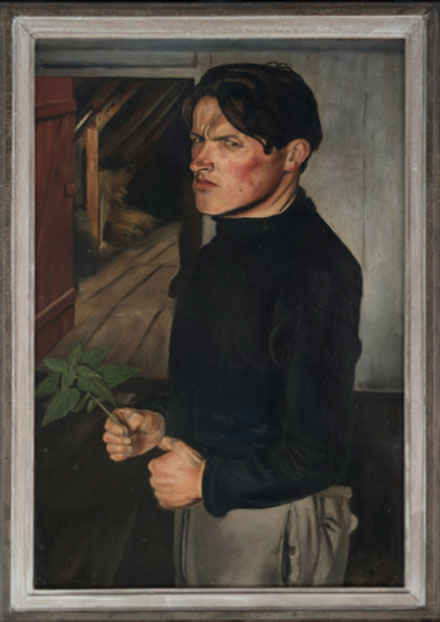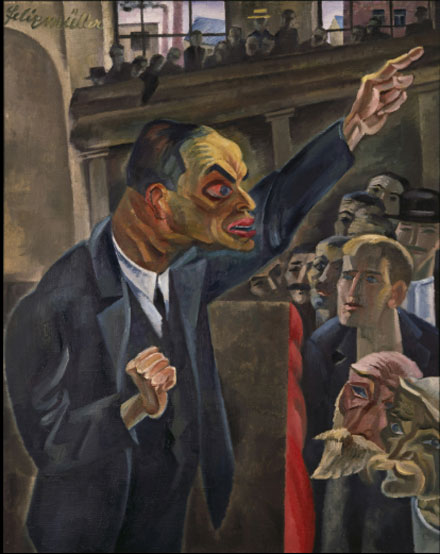Exhibit ends June 22, 2025
Fort Worth, Texas -- The Kimbell Art Museum will present the special exhibition Modern Art and Politics in Germany 1910–1945: Masterworks from the Neue Nationalgalerie, Berlin, March 30–June 22, 2025. This exhibition brings together more than seventy paintings and sculptures from the collection of the Neue Nationalgalerie, Germany’s distinguished modern art museum. It traces the German experience in the visual arts from the last years of the German Empire, World War I and the liberal Weimar Republic that followed to the rise of National Socialism and Adolf Hitler, the Holocaust, and World War II. Paintings and sculptures by artists including Max Beckmann, Otto Dix, George Grosz, Hannah Höch, Wassily Kandinsky, Ernst Ludwig Kirchner, Paul Klee, Käthe Kollwitz, Gabriele Münter, and Christian Schad show how modern art played an important role in the discourse during these critical decades in twentieth-century political history and how politics, at the same time, influenced the visual arts. Most of the works on view in this exhibition have never before been shown in the United States.

“This is the first special exhibition ever held at the Kimbell devoted to painting and sculpture in Germany during the fraught, tumultuous first half of the twentieth century,” said Eric Lee, director of the Kimbell Art Museum. “We are grateful to the Neue Nationalgalerie, Berlin for the opportunity to provide this experience in Texas.”
The exhibition leads visitors through the great shifts in art and politics that took place between 1910 and 1945 in six thematic sections, beginning with Expressionism. In the first decade of the twentieth century, artists challenged the status quo of German art, painting and sculpting roughly drawn and vividly colored works. The Expressionists’ works were political in their objection to the conservative taste of their times, and specifically that of Kaiser Wilhelm II.

Many German Expressionist artists were given prominent places in German museums in the wake of the first World War but were later often banned under Hitler. This gallery will include Ernst Ludwig Kirchner’s Self Portrait with a Girl, 1914-15, and Emil Nolde’s 1909 Pentecost, among paintings by other influential artists.
The next section features the Neue Sachlichkeit (New Objectivity), a movement that typified the modern style of the 1920s. These artists rejected the seemingly crude brushwork and dissonant colors of Expressionism, seeking to adapt to a new post-war social order in the liberal climate of the so-called Weimar Republic, the democratic government that was ushered in at the end of World War I and lasted until Adolf Hitler seized power in 1933. Their paintings were often marked by careful draftsmanship, sober brushwork, and a kind of hyper-realism that gave a modern interpretation of the traditions of German Renaissance art.

This section includes works by artists who may be less well-known to American audiences but who have long been celebrated in Germany and recognized by artists and historians worldwide. Among them are Kate Diehn-Bitt, Kurt Günther, Franz Radziwill, and Christian Schad, whose 1928 painting Sonja is among the most famous icons of the movement.
From this rediscovery of realism, museum visitors move to galleries featuring the International Avant-Gardes that found favor in the 1910s and ‘20s, when modern art from across Europe was exhibited in Germany. At this time, more than ever before, art from abroad was featured in museums and commercial galleries. In this exhibition, portraits of three influential art dealers will join works by the foreign artists they promoted: Afred Flechtheim by the painter Otto Dix; Herwarth Walden by the sculptor William Wauer; and Heinrich Thannhauser, in the painting by Lovis Corinth from the Kimbell’s own collection. This section of the exhibition includes works by such European artists as Pablo Picasso, Fernand Léger, Oskar Kokoschka, and Marianne von Werefkin.
The exhibition next reveals ways that Modes of Abstraction entered and influenced German art in the years between the world wars. For example, the Cubism of Picasso, Georges Braque, and Léger exerted a strong influence in Germany, on painters such as Lyonel Feininger, Paul Klee, Gabriele Münter, and Georg Muche, whose works are displayed here. Feininger, Klee, and Muche were on the faculty of the Bauhaus, the famed art school, along with Wassily Kandinsky, and Oskar Schlemmer, also featured in this section of the exhibition.
Politics and War demonstrates how artistic movements engaged directly with modern society and, by extension, with political issues. Some artists did so quite explicitly: George Grosz, in his famous 1926 Pillars of Society, blatantly ridiculed the establishment—political, military, and religious. The works in this gallery plot the course of events that led from Germany’s defeat in 1918 to the rise of militant nationalism in the 1930s, to a second world war, and to the Nazi atrocities that shocked nations worldwide. Examples include Wilhelm Lehmbruck’s mournful bronze sculpture Fallen Man, and Horst Strempel’s magnum opus, Night Over Germany, a denunciation of the Nazis’ barbarism in the form of a Christian altarpiece.
The exhibition concludes with an epilogue titled Before and After. This gallery includes works by some artists who had been exiled, who had been labeled as “degenerate,” or who were otherwise grappling with the political and humanitarian realities of post-war Germany, from the point of view of their art before the war and their history in the post-war era. Among the works seen in this concluding chapter of the exhibition are Max Beckmann’s melancholy 1942 Self Portrait in a Bar and Salvador Dalí’s Portrait of Mrs. Isabel Styler-Tas, painted in exile in Beverly Hills, California, in 1945.
“The works in this exhibition are powerful, masterful,” said George T. M. Shackelford, deputy director of the Kimbell Art Museum. “And the stories that they tell about their turbulent times are gripping.”
ORGANIZATION AND CATALOGUE
Modern Art and Politics in Germany 1910–1945: Masterworks from the Neue Nationalgalerie, Berlin has been organized by the Neue Nationalgalerie, Berlin, in cooperation with the Kimbell Art Museum. The curators of the exhibition are Dieter Scholz, George T. M. Shackelford, and Irina Hiebert Grun.
The richly illustrated catalogue accompanying the exhibition is edited by George T. M. Shackelford, Irina Hiebert Grun, and Joachim Jäger, with major contributions by Dieter Scholz, Irina Hiebert Grun, and George T. M. Shackelford, and commentary on each work by a wide variety of German scholars.
SUPPORT
Promotional support for the Kimbell Art Museum and its exhibitions is provided by American Airlines, the Fort Worth Report, and NBC 5. Additional support is provided by Arts Fort Worth and the Texas Commission on the Arts.
VISITOR INFORMATION
Admission to the museum’s permanent collection is always free. Admission is half-price all day on Tuesdays and after 5 p.m. on Fridays.
The Kimbell Art Museum is open Tuesdays through Thursdays and Saturdays, 10 a.m.–5 p.m.; Fridays, noon–8 p.m.; Sundays, noon–5 p.m.; closed Mondays, New Year’s Day, Juneteenth, July 4, Thanksgiving, and Christmas. For general information, call 817-332-8451.
ABOUT THE KIMBELL ART MUSEUM
The Kimbell Art Museum, owned and operated by the Kimbell Art Foundation, is internationally renowned for both its collections and its architecture. The Kimbell’s collections range in period from antiquity to the twentieth century and include European masterpieces by artists such as Fra Angelico, Michelangelo, Caravaggio, Bernini, Velázquez, Vigée Le Brun, Monet, Cézanne, Picasso, and Matisse; important collections of Egyptian and classical antiquities; and the art of Asia, Africa, and the Ancient Americas.
The museum’s 1972 building, designed by the American architect Louis I. Kahn, is widely regarded as one of the outstanding architectural achievements of the modern era. A second building, designed by Italian architect Renzo Piano, opened in 2013 and now provides space for special exhibitions, dedicated classrooms, and a 289-seat auditorium with excellent acoustics for music. For more information, visit kimbellart.org.
ABOUT THE NEUE NATIONALGALERIE, BERLIN
The Neue Nationalgalerie is a museum dedicated to 20th-century art. The collection brings together an array of key artworks from the twentieth century by various artists from Europe and North America, including Francis Bacon, Max Beckmann, Salvador Dalí, Max Ernst, George Grosz, Hannah Höch, Rebecca Horn, Ernst Ludwig Kirchner, Paul Klee, Lotte Laserstein, Paula Modersohn-Becker, Edvard Munch, Ernst Wilhelm Nay, Pablo Picasso, Gerhard Richter, Werner Tübke, and Andy Warhol.
The Neue Nationalgalerie, opened in 1968, was the last major project completed by the internationally famous architect Ludwig Mies van der Rohe. His long-term preoccupation with creating pillar-free, open spaces culminated in the design of the museum’s glass hall. With its steel roof and gracefully austere architectural forms, the Neue Nationalgalerie is an icon of modernism and a testament to a visionary 20th-century architect.

